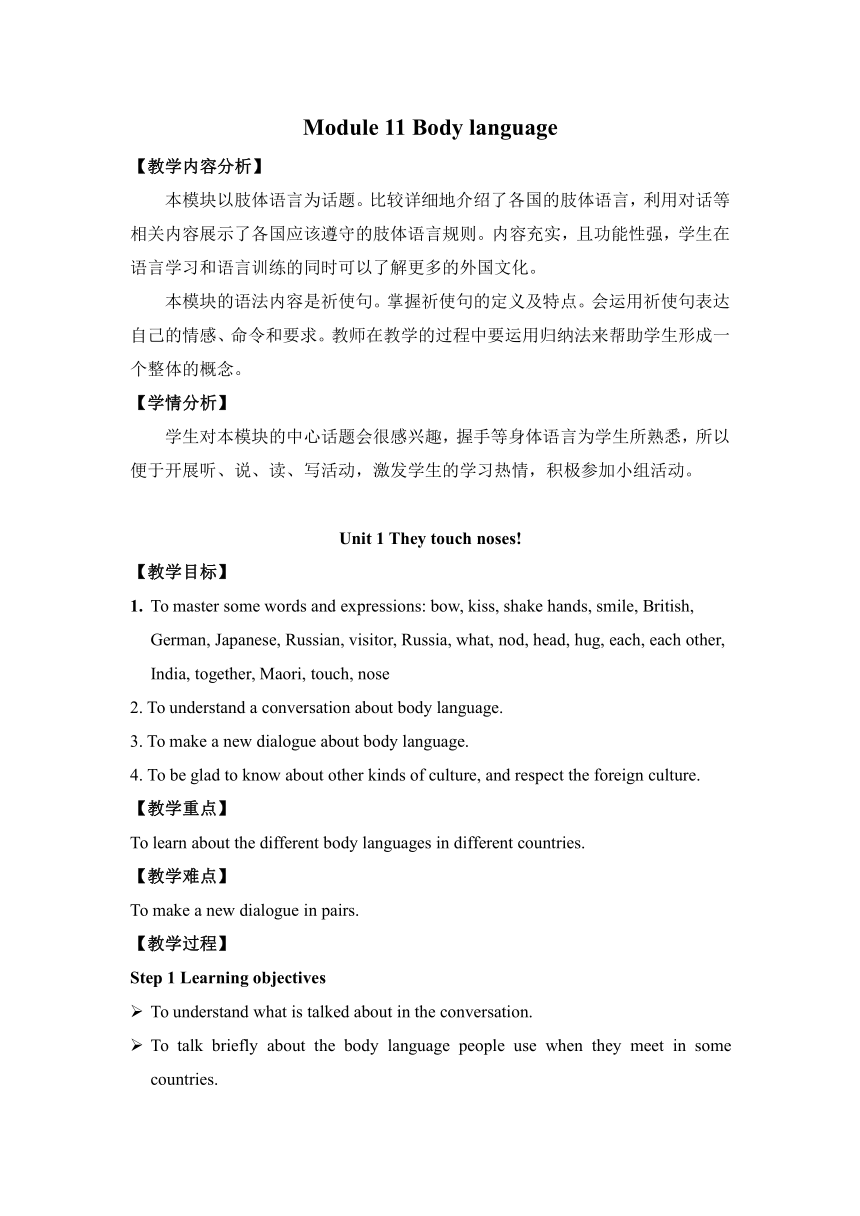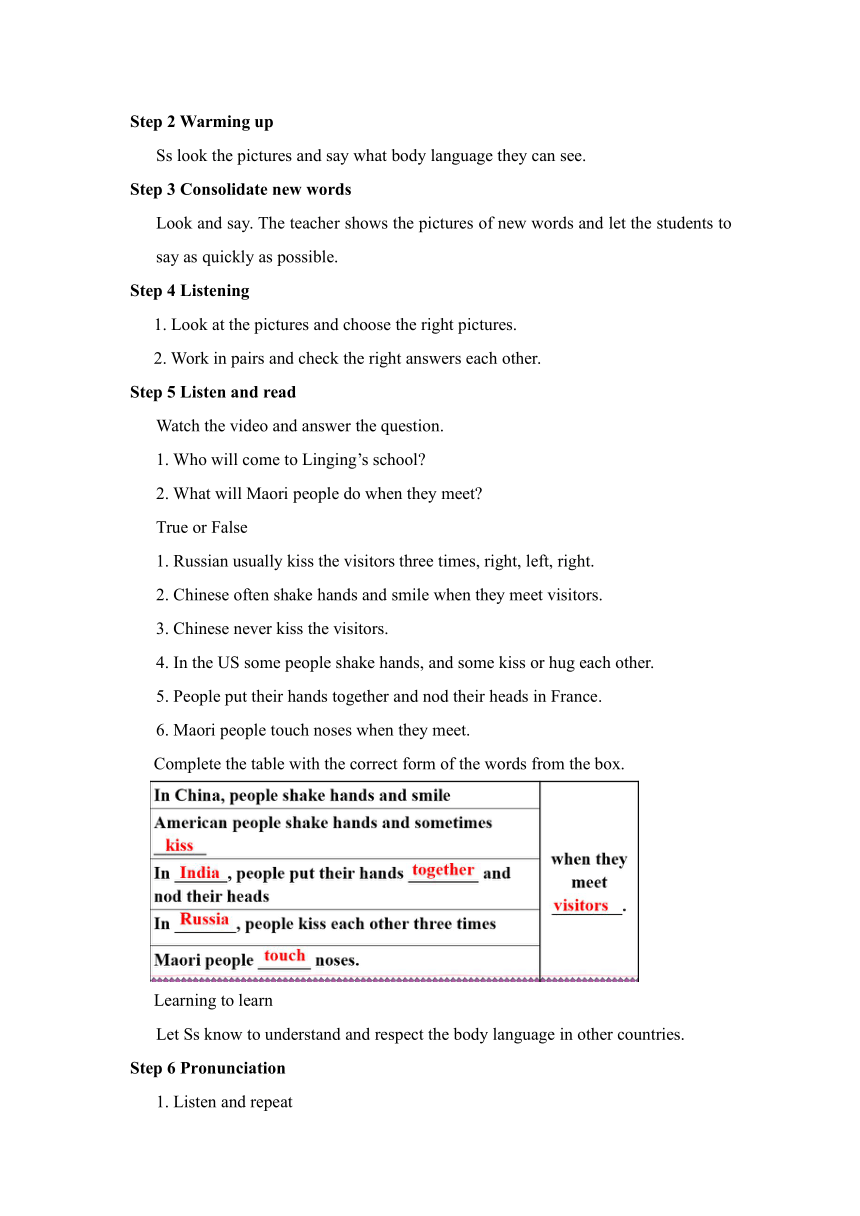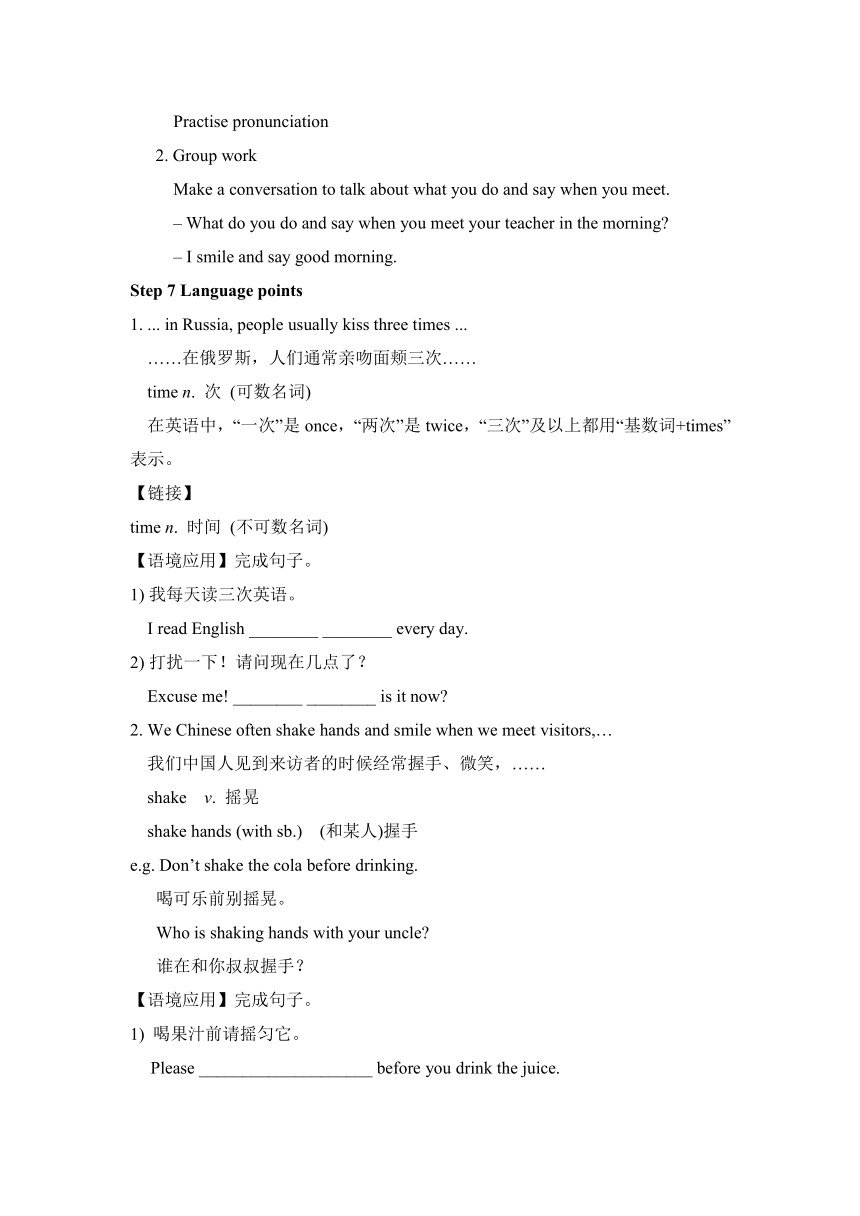Module 11 Unit 1 They touch noses教案 2023-2024学年外研版英语七年级下册
文档属性
| 名称 | Module 11 Unit 1 They touch noses教案 2023-2024学年外研版英语七年级下册 |

|
|
| 格式 | docx | ||
| 文件大小 | 90.7KB | ||
| 资源类型 | 教案 | ||
| 版本资源 | 外研版 | ||
| 科目 | 英语 | ||
| 更新时间 | 2024-02-23 16:03:58 | ||
图片预览



文档简介
Module 11 Body language
【教学内容分析】
本模块以肢体语言为话题。比较详细地介绍了各国的肢体语言,利用对话等相关内容展示了各国应该遵守的肢体语言规则。内容充实,且功能性强,学生在语言学习和语言训练的同时可以了解更多的外国文化。
本模块的语法内容是祈使句。掌握祈使句的定义及特点。会运用祈使句表达自己的情感、命令和要求。教师在教学的过程中要运用归纳法来帮助学生形成一个整体的概念。
【学情分析】
学生对本模块的中心话题会很感兴趣,握手等身体语言为学生所熟悉,所以便于开展听、说、读、写活动,激发学生的学习热情,积极参加小组活动。
Unit 1 They touch noses!
【教学目标】
To master some words and expressions: bow, kiss, shake hands, smile, British, German, Japanese, Russian, visitor, Russia, what, nod, head, hug, each, each other, India, together, Maori, touch, nose
2. To understand a conversation about body language.
3. To make a new dialogue about body language.
4. To be glad to know about other kinds of culture, and respect the foreign culture.
【教学重点】
To learn about the different body languages in different countries.
【教学难点】
To make a new dialogue in pairs.
【教学过程】
Step 1 Learning objectives
To understand what is talked about in the conversation.
To talk briefly about the body language people use when they meet in some countries.
Step 2 Warming up
Ss look the pictures and say what body language they can see.
Step 3 Consolidate new words
Look and say. The teacher shows the pictures of new words and let the students to say as quickly as possible.
Step 4 Listening
1. Look at the pictures and choose the right pictures.
2. Work in pairs and check the right answers each other.
Step 5 Listen and read
Watch the video and answer the question.
1. Who will come to Linging’s school
2. What will Maori people do when they meet
True or False
1. Russian usually kiss the visitors three times, right, left, right.
2. Chinese often shake hands and smile when they meet visitors.
3. Chinese never kiss the visitors.
4. In the US some people shake hands, and some kiss or hug each other.
5. People put their hands together and nod their heads in France.
6. Maori people touch noses when they meet.
Complete the table with the correct form of the words from the box.
Learning to learn
Let Ss know to understand and respect the body language in other countries.
Step 6 Pronunciation
1. Listen and repeat
Practise pronunciation
2. Group work
Make a conversation to talk about what you do and say when you meet.
– What do you do and say when you meet your teacher in the morning
– I smile and say good morning.
Step 7 Language points
1. ... in Russia, people usually kiss three times ...
……在俄罗斯,人们通常亲吻面颊三次……
time n. 次 (可数名词)
在英语中,“一次”是once,“两次”是twice,“三次”及以上都用“基数词+times”表示。
【链接】
time n. 时间 (不可数名词)
【语境应用】完成句子。
1) 我每天读三次英语。
I read English ________ ________ every day.
2) 打扰一下!请问现在几点了?
Excuse me! ________ ________ is it now
2. We Chinese often shake hands and smile when we meet visitors,…
我们中国人见到来访者的时候经常握手、微笑,……
shake v. 摇晃
shake hands (with sb.) (和某人)握手
e.g. Don’t shake the cola before drinking.
喝可乐前别摇晃。
Who is shaking hands with your uncle
谁在和你叔叔握手?
【语境应用】完成句子。
1) 喝果汁前请摇匀它。
Please ____________________ before you drink the juice.
2) Mr Smith微笑着和他们握手。
Mr Smith smiled and ____________________.
表示“某国人”的名词,单数变复数有以下几种情况:
① 大多数表示“某国人”的名词变复数,符合一般名词的复数变化规律,词尾直接加-s。
如:Americans, Russians等。
② 词尾若为-ese,其单复数同形。
如:Chinese和Japanese。
③ 以-man结尾的复数“某国人”,应将man改为men,
如:Englishmen, Frenchmen。
但German除外,应直接加-s,即Germans。
smile v. 微笑
smile at sb. 对某人微笑
n. 微笑;笑容 (可数名词)
e.g. She left with a smile.
她微笑着离开了。
The boy smiled when he saw his friend. (翻译)
这个男孩看到他朋友时笑了。
【语境应用】完成句子
1) 李婷总是微笑。
Li Ting always ________.
2) 鲁老师刚才对我微笑了。
Ms Lu ________ ________ me just now.
3) 她的脸上有笑容。
There is ________ ________ on her face.
3. That’s because people do different things in different countries.
那是因为不同国家的人做法不同。
That’s because ... 那是因为…… (后跟句子说明具体原因)
e.g. That’s because it’s late.
那是因为天晚了。
【链接】
That’s why ...也是一个常用句式,后跟句子说明结果,表示“那就是为什么……”。
e.g. That’s why he got the best scores.
那就是为什么他取得了最好的成绩。
And some kiss or hug each other.
还有一些人亲吻或者相互拥抱。
each pron. 各个;每个 (两个或两个以上的人或物中的)
可与介词of连用,后接复数名词或代词;each (of ...)作主语时,谓语动词通常用单数;用于复数主语后,谓语动词用复数。
each adj. 每个
用于单数名词前,后接单数动词。
each other 彼此,互相 (后接复数名词或代词作主语时,谓语动词常用单数)
【链接】
every也有“每个”的意思,但只作形容词,常用于指三个或三个以上的人或物中的“每个”。“every one of +复数名词或代词”表示“……中的每个”,后接复数名词或代词,谓语动词通常用单数。
【语境应用】
Ⅰ. 完成句子。
1) 每个学生都有一张书桌。
________________ student _______ a desk.
2) 刘阿姨有三个孩子。每个都在不同的学校读书。
Aunt Liu has three children. _______ _______ to a different school.
3) 这家宾馆的每个房间有一台电脑。
There is one computer in _______ _______ the rooms in the hotel.
Ⅱ. 选词填空。
1) I've got two brothers. _______(Every / Each) of them _______(is / are) nice to me.
2) There are four questions. _______(Every / Each) one of the questions _______(take / takes) two minutes to answer.
Step 8 Summary
shake hands
each other
three times
nod one’s head
put ... together
touch noses
body language
Step 9 Exercises
Ⅰ. 根据语境及所给汉语提示语或首字母提示写出或补全所缺单词。
1. ________(每个) of us has a good time in the park.
2. Mr Bean has got funny eyes and a big ________(鼻子).
3. Ms Zhang is very strict. She never ________ (微笑).
4. You know, people usually nod their h________ to say “yes”.
5. Don’t t________ that dog, Michael! It’s dangerous.
Ⅱ. 根据语境,从方框中选择恰当的单词填空,注意形式变化。
visit, time, Russia, kiss, together
1. My friend Anna is from Russia. She speaks ________.
2. Jane goes to the school library three ________ a week.
3. A lot of ________ go to the Palace Museum every year.
4. “Stand close ________. I don’t want anyone to get lost,” the teacher said.
5. It’s time to go to bed, boy. And ________ your mother goodnight.
Step 10 Homework
Write short dialogues about what do you do when you meet:
your best friend
your best friend’s parents
your favorite film star
a visitor to your school
【教学内容分析】
本模块以肢体语言为话题。比较详细地介绍了各国的肢体语言,利用对话等相关内容展示了各国应该遵守的肢体语言规则。内容充实,且功能性强,学生在语言学习和语言训练的同时可以了解更多的外国文化。
本模块的语法内容是祈使句。掌握祈使句的定义及特点。会运用祈使句表达自己的情感、命令和要求。教师在教学的过程中要运用归纳法来帮助学生形成一个整体的概念。
【学情分析】
学生对本模块的中心话题会很感兴趣,握手等身体语言为学生所熟悉,所以便于开展听、说、读、写活动,激发学生的学习热情,积极参加小组活动。
Unit 1 They touch noses!
【教学目标】
To master some words and expressions: bow, kiss, shake hands, smile, British, German, Japanese, Russian, visitor, Russia, what, nod, head, hug, each, each other, India, together, Maori, touch, nose
2. To understand a conversation about body language.
3. To make a new dialogue about body language.
4. To be glad to know about other kinds of culture, and respect the foreign culture.
【教学重点】
To learn about the different body languages in different countries.
【教学难点】
To make a new dialogue in pairs.
【教学过程】
Step 1 Learning objectives
To understand what is talked about in the conversation.
To talk briefly about the body language people use when they meet in some countries.
Step 2 Warming up
Ss look the pictures and say what body language they can see.
Step 3 Consolidate new words
Look and say. The teacher shows the pictures of new words and let the students to say as quickly as possible.
Step 4 Listening
1. Look at the pictures and choose the right pictures.
2. Work in pairs and check the right answers each other.
Step 5 Listen and read
Watch the video and answer the question.
1. Who will come to Linging’s school
2. What will Maori people do when they meet
True or False
1. Russian usually kiss the visitors three times, right, left, right.
2. Chinese often shake hands and smile when they meet visitors.
3. Chinese never kiss the visitors.
4. In the US some people shake hands, and some kiss or hug each other.
5. People put their hands together and nod their heads in France.
6. Maori people touch noses when they meet.
Complete the table with the correct form of the words from the box.
Learning to learn
Let Ss know to understand and respect the body language in other countries.
Step 6 Pronunciation
1. Listen and repeat
Practise pronunciation
2. Group work
Make a conversation to talk about what you do and say when you meet.
– What do you do and say when you meet your teacher in the morning
– I smile and say good morning.
Step 7 Language points
1. ... in Russia, people usually kiss three times ...
……在俄罗斯,人们通常亲吻面颊三次……
time n. 次 (可数名词)
在英语中,“一次”是once,“两次”是twice,“三次”及以上都用“基数词+times”表示。
【链接】
time n. 时间 (不可数名词)
【语境应用】完成句子。
1) 我每天读三次英语。
I read English ________ ________ every day.
2) 打扰一下!请问现在几点了?
Excuse me! ________ ________ is it now
2. We Chinese often shake hands and smile when we meet visitors,…
我们中国人见到来访者的时候经常握手、微笑,……
shake v. 摇晃
shake hands (with sb.) (和某人)握手
e.g. Don’t shake the cola before drinking.
喝可乐前别摇晃。
Who is shaking hands with your uncle
谁在和你叔叔握手?
【语境应用】完成句子。
1) 喝果汁前请摇匀它。
Please ____________________ before you drink the juice.
2) Mr Smith微笑着和他们握手。
Mr Smith smiled and ____________________.
表示“某国人”的名词,单数变复数有以下几种情况:
① 大多数表示“某国人”的名词变复数,符合一般名词的复数变化规律,词尾直接加-s。
如:Americans, Russians等。
② 词尾若为-ese,其单复数同形。
如:Chinese和Japanese。
③ 以-man结尾的复数“某国人”,应将man改为men,
如:Englishmen, Frenchmen。
但German除外,应直接加-s,即Germans。
smile v. 微笑
smile at sb. 对某人微笑
n. 微笑;笑容 (可数名词)
e.g. She left with a smile.
她微笑着离开了。
The boy smiled when he saw his friend. (翻译)
这个男孩看到他朋友时笑了。
【语境应用】完成句子
1) 李婷总是微笑。
Li Ting always ________.
2) 鲁老师刚才对我微笑了。
Ms Lu ________ ________ me just now.
3) 她的脸上有笑容。
There is ________ ________ on her face.
3. That’s because people do different things in different countries.
那是因为不同国家的人做法不同。
That’s because ... 那是因为…… (后跟句子说明具体原因)
e.g. That’s because it’s late.
那是因为天晚了。
【链接】
That’s why ...也是一个常用句式,后跟句子说明结果,表示“那就是为什么……”。
e.g. That’s why he got the best scores.
那就是为什么他取得了最好的成绩。
And some kiss or hug each other.
还有一些人亲吻或者相互拥抱。
each pron. 各个;每个 (两个或两个以上的人或物中的)
可与介词of连用,后接复数名词或代词;each (of ...)作主语时,谓语动词通常用单数;用于复数主语后,谓语动词用复数。
each adj. 每个
用于单数名词前,后接单数动词。
each other 彼此,互相 (后接复数名词或代词作主语时,谓语动词常用单数)
【链接】
every也有“每个”的意思,但只作形容词,常用于指三个或三个以上的人或物中的“每个”。“every one of +复数名词或代词”表示“……中的每个”,后接复数名词或代词,谓语动词通常用单数。
【语境应用】
Ⅰ. 完成句子。
1) 每个学生都有一张书桌。
________________ student _______ a desk.
2) 刘阿姨有三个孩子。每个都在不同的学校读书。
Aunt Liu has three children. _______ _______ to a different school.
3) 这家宾馆的每个房间有一台电脑。
There is one computer in _______ _______ the rooms in the hotel.
Ⅱ. 选词填空。
1) I've got two brothers. _______(Every / Each) of them _______(is / are) nice to me.
2) There are four questions. _______(Every / Each) one of the questions _______(take / takes) two minutes to answer.
Step 8 Summary
shake hands
each other
three times
nod one’s head
put ... together
touch noses
body language
Step 9 Exercises
Ⅰ. 根据语境及所给汉语提示语或首字母提示写出或补全所缺单词。
1. ________(每个) of us has a good time in the park.
2. Mr Bean has got funny eyes and a big ________(鼻子).
3. Ms Zhang is very strict. She never ________ (微笑).
4. You know, people usually nod their h________ to say “yes”.
5. Don’t t________ that dog, Michael! It’s dangerous.
Ⅱ. 根据语境,从方框中选择恰当的单词填空,注意形式变化。
visit, time, Russia, kiss, together
1. My friend Anna is from Russia. She speaks ________.
2. Jane goes to the school library three ________ a week.
3. A lot of ________ go to the Palace Museum every year.
4. “Stand close ________. I don’t want anyone to get lost,” the teacher said.
5. It’s time to go to bed, boy. And ________ your mother goodnight.
Step 10 Homework
Write short dialogues about what do you do when you meet:
your best friend
your best friend’s parents
your favorite film star
a visitor to your school
同课章节目录
- Module 1 Lost and found
- Unit 1 Whose bag is this?
- Unit 2 Are they yours?
- Unit 3 Language in use
- Module 2 What can you do ?
- Unit 1 I can play the piano
- Unit 2 I can run really fast
- Unit 3 Language in use
- Module 3 Making plans
- Unit 1 What are you going to do at the weekends?
- Unit 2 We're going to cheer the players.
- Unit 3 Language in use
- Module 4 Life in the future
- Unit 1 Everyone will study at home
- Unit 2 Every family will have a small plane.
- Unit 3 Language in use
- Module 5 Shopping
- Unit 1 What can I do for you?
- Unit 2 You can buy everything on the Internet
- Unit 3 Language in use
- Module 6 Around town
- Unit 1 Could you tell me how to get to the Nationa
- Unit 2 The London Eye is on your right.
- Unit 3 Language in use
- Revision module A
- Module 7 My past life
- Unit 1 I was born in a small village.
- Unit 2 I was born in Quincy.
- Unit 3 Language in use
- Module 8 Story time
- Unit 1 Once upon a time….
- Unit 2 Goldilocks hurried out of the house.
- Unit 3 Language in use
- Module 9 Life history
- Unit 1 He left school and began work at the age of
- Unit 2 He decided to be an actor.
- Unit 3 Language in use
- Module 10 A holiday journey
- Unit 1 What did you do?
- Unit 2 This morning we took a walk.
- Unit 3 Language in use
- Module 11 Body language
- Unit 1 They touch noses!
- Unit 2 Here are some ways to welcome them.
- Unit 3 Language in use
- Module 12 Western music
- Unit 1 It's so beautiful!
- Unit 2 Vienna is the centre of European classical
- Unit 3 Language in use
- Revision module B
